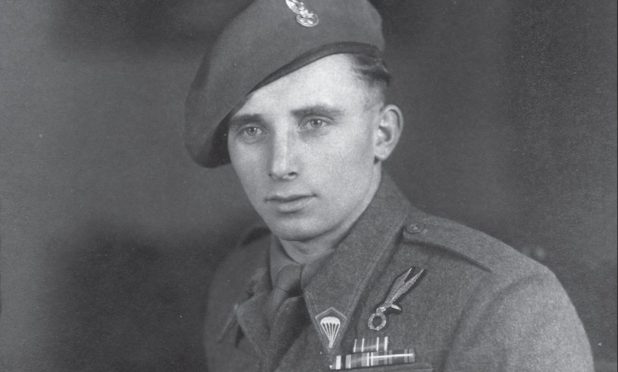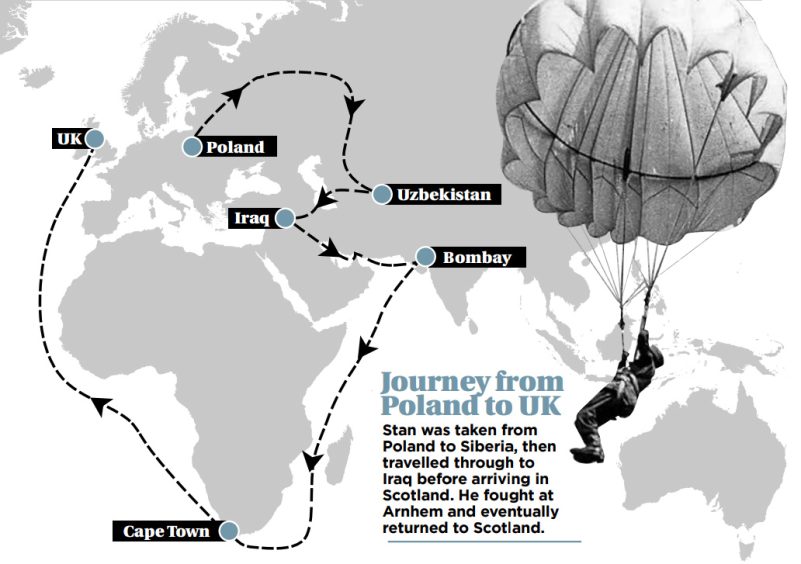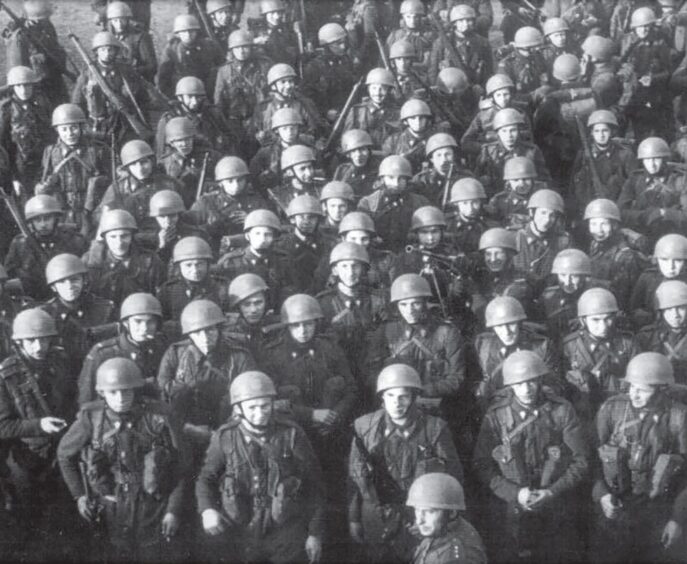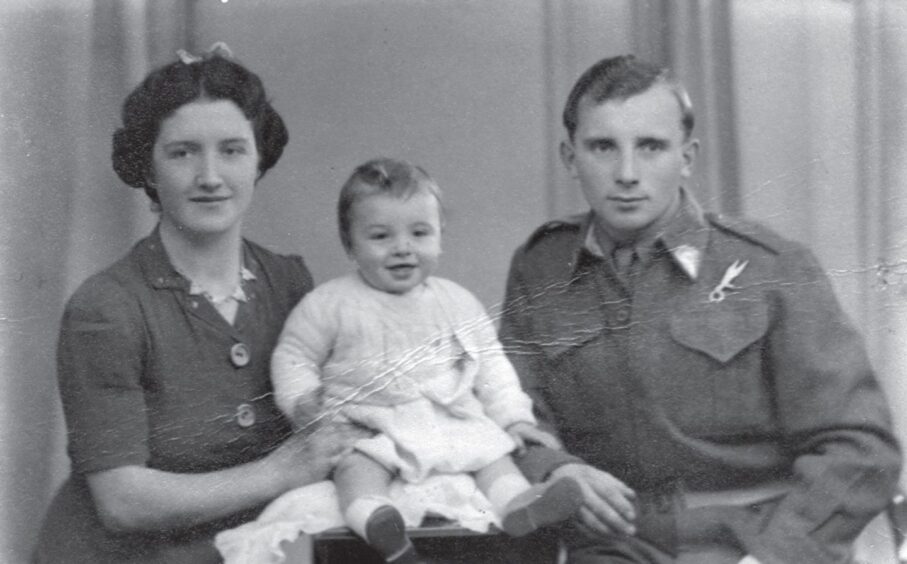
As a teenager, Stanislaw Kulik had a habit of cheating death as he bounced across half the world during the Second World War.
After his family was forced from their home in Poland and sent to a Russian Gulag, Stanislaw’s story winds across Eastern Europe and Asia, to a refugee camp in Iraq, then to India for a ship bound for the UK, where he eventually landed in Scotland.
Stanislaw, known as Stan, trained as a paratrooper as part of a Polish Brigade in Fife and was later dropped behind enemy lines at the Battle of Arnhem, narrowly evading capture with help from the Dutch resistance.
Now, more than 80 years later, his grandson, Nicholas Kinloch, has helped to recount an early life that plays out like the plot of big-screen wartime epic in a new, riveting memoir.
“People had come to him before, asking to tell his story but he always turned them down. He wanted it to be shared by someone in the family,” said Nicholas.
In From The Soviet Gulag To Arnhem: A Polish Paratrooper’s Epic Wartime Journey, Stan recounts six years that took him halfway across the world before he finally settled with his Scottish wife, Isa, in Boarhills near St Andrews, where they lived happily for 70 years.
Some of Nicholas’ earliest memories of his grandfather were listening to snippets of his war stories. “I’ve known his story all my life as he would always retell us certain parts but it was incredible to hear his mind-blowing story chronologically,” said Nicholas.
“There are many remarkable stories from that time but I do think my grandad’s story is unique in terms of travelling solo through Siberia and Central Asia and eventually becoming a paratrooper at such a young age. He showed incredible courage and resilience.”
Nicholas, an educational psychologist based in London, began recording his grandad’s incredible war story 16 years ago. Over six months, he travelled from his then home in Edinburgh to his grandparents near St Andrews. Nicholas and his grandmother would listen, fascinated, for hours as Stan, then 83, recounted his wartime years with remarkable clarity and detail.
It proved an incredible experience, said Nicholas. “Obviously parts of it were very emotional, especially what happened to his family in Siberia. But, overall, he was happy to talk about it and I think it was cathartic for him. He really appreciated the opportunity to tell his story.”
Stan passed away in 2016 aged 92, following seven decades of happy family life in Scotland. Nicholas’ notes lay untouched for almost 13 years, until 2020, when he found time to record his grandad’s story.
Stan was just 15 when his family was forced to leave their home in the village of Obrentchuvka in Eastern Poland and was put on a train to a Russian Gulag in Siberia. He was forced to do manual labour, such as felling trees, 12 hours a day, six days a week.
Devastatingly, Stan’s mother and younger brother, Mietel, died in Siberia. His mother was buried in an unmarked grave.
Stan survived the horror of the camp and, at 17, was sent to join a secret Polish Army being assembled by the Soviets and embarked on an arduous solo journey through Siberia, Uzbekistan and Kazakhstan. It would be years before he saw his father and sister Rozia again.
“When the Nazis invaded the Soviet Union, the Soviets allowed the Poles to leave the camps to join a spectre Polish army somewhere in central Asia but gave them no directions,” said Nicholas. “He was separated from his older brother and ended up wandering through Kazakhstan and Uzbekistan alone for three months trying to find information about this army.
“He eventually found a recruiting station in Uzbekistan. The British Army had made a deal with the Soviets allowing Poles out of the Soviet Union, so he was sent to a refugee camp in Iraq via Iran.”
Stan was given a job processing and supporting his fellow Polish refugees. In 1943, he and a number of other Polish soldiers were put on a ship to Bombay and later set sail on the SS Mariposa. After many weeks and a quick stop in Cape Town, South Africa, Stan finally made his way to Britain.
He was put on a train to Scotland and trained as a paratrooper with the 10th Company, 3rd Battalion, based in Elie and Earlsferry in Fife. He met Isa at a dance in nearby Colinsburgh.
Stan later joined the British 1st Airborne Division and was dropped at the Battle of Arnhem in September 1944. About 1,600 British soldiers died during the nine-day assault in the Dutch city, and Stan was, temporarily, one of 6,500 captured British troops.
“My grandad loved telling us the story of how he was dropped at Arnhem and trapped behind enemy lines,” recalled Nicholas. “I think he was one of the few Polish paratroopers to make it across the River Rhine to support the British paratroopers and ended up in the line of fire. When the British forces were pulled back, he was trapped on the German side of the river.”
The extraordinary tale of how Stan evaded German capture continues to astound Nicholas. He explained: “Grandad was initially captured by the Germans and taken to a makeshift hospital. Each day, they’d take a soldier away, so grandad would hide in the toilet. One of the nurses was actually part of the Dutch Underground and helped him escape.
“She got him a bicycle and Dutch clothes and they cycled right past the guards. Later, they were cycling past another group of German soldiers when the chain on his bike broke. He couldn’t tell anyone because he couldn’t speak Dutch, so he had this nerve-racking moment where he had to stop to fix the chain, hoping the Nazis wouldn’t notice him.”
After a thankfully quick bike repair, Stan and his rescuers eventually made it to a safe house.
“Members of the Dutch Underground hid him in various safe houses before he could eventually get out. At one point, Nazis entered a house and he had to hide behind a pram with a coat over him. They were in the room for hours before they finally left,” said Nicholas. He was later hidden in a hole in the middle of a forest for a few weeks until the Dutch smuggled him and a small group of British paratroopers across German lines in a vehicle disguised as a Red Cross truck to a boat on the River Rhine.
“Grandad said he was so nervous and paddling so fast that the boat was nearly going in circles, but they eventually made it across to the allied territory.”
Nicholas added: “There were so many remarkable things that happened to him within this larger story. Helping to retell it has given me a greater appreciation of the man he was and shown me another fascinating side of him. He was one tough cookie but always happy and kind despite those terrible experiences.”

Years later, Stan would return to the Netherlands to commemorate the Battle of Arnhem and received honorary medals from the Dutch government.
Following the war, Stan returned to Scotland, married Isa and settled in Boarhills, five miles from St Andrews. He worked on a farm for many years and later in road maintenance and as a gardener. Stan and Isa were married for 70 years and had two children and three grandchildren.
Stan’s bother, Billy, settled on the Isle of Wight but it was many years before Stan was able to reunite with his father and sister Rozia, in Poland. He drove from Scotland to Poland in the 1960s to see his family and visited them once more in 2008.
“He knew he couldn’t go back to Poland because of the Cold War and that he’d never see his family again, so he focused everything into building this new, happy life in Scotland,” Nicholas added.
Nicholas is still trying to track down relatives of the members of the Dutch Underground, to whom his grandfather owes his life. “Apart from local paratroopers who settled near him, grandad wasn’t able to keep in touch with anyone,” he said. “I’ve always wanted to find out more about the Dutch Underground.
“One person gave grandad a photo of the music band he was in. There’s what looks like an address written on the back which I’m still trying to decipher. I’d like to keep exploring that.”
He is proud to preserve his grandad’s story of resilience and fortitude, “My one regret is my grandparents aren’t alive to see the book but I think they’d be proud,” Nicholas added. “I keep thinking it would make a good movie, so maybe one day… who knows?”
From The Soviet Gulag To Arnhem by Nicholas Kinloch is published by Pen and Sword, out now.

Enjoy the convenience of having The Sunday Post delivered as a digital ePaper straight to your smartphone, tablet or computer.
Subscribe for only £5.49 a month and enjoy all the benefits of the printed paper as a digital replica.
Subscribe
